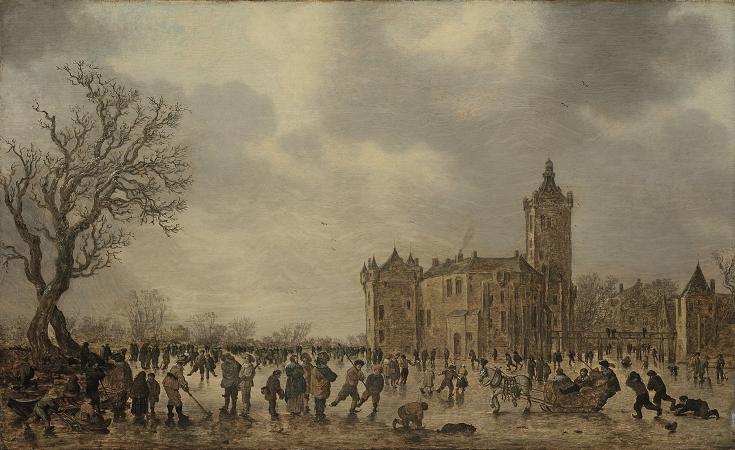
Landscape with Skaters. Ice skating is the self-propulsion of a person across a sheet of ice, using metal-bladed ice skates to glide on the ice surface.
This activity can be carried out for various reasons, including recreation, sport, exercise, and travel. Ice skating may be performed on specially prepared ice surfaces, both indoors and outdoors, as well as on naturally occurring bodies of frozen water, such as ponds, lakes and rivers.
Research suggests that the earliest ice skating happened in southern Finland more than 4,000 years ago. This was done to save energy during winter journeys.
True skating emerged when a steel blade with sharpened edges was used. Skates now cut into the ice instead of gliding on top of it. Adding edges to ice skates was invented by the Dutch in the 13th or 14th century.
These ice skates were made of steel, with sharpened edges on the bottom to aid movement. The fundamental construction of modern ice skates has stayed largely the same since then, although differing greatly in the details, particularly in the method of binding and the shape and construction of the steel blades. In the Netherlands, ice skating was considered proper for all classes of people, as shown in many pictures by the Old Masters. Ice skating was also practiced in China during the Song dynasty, and became popular among the ruling family of the Qing dynasty. Ice skating was brought to Britain from the
This activity can be carried out for various reasons, including recreation, sport, exercise, and travel. Ice skating may be performed on specially prepared ice surfaces, both indoors and outdoors, as well as on naturally occurring bodies of frozen water, such as ponds, lakes and rivers.
Research suggests that the earliest ice skating happened in southern Finland more than 4,000 years ago. This was done to save energy during winter journeys.
True skating emerged when a steel blade with sharpened edges was used. Skates now cut into the ice instead of gliding on top of it. Adding edges to ice skates was invented by the Dutch in the 13th or 14th century.
These ice skates were made of steel, with sharpened edges on the bottom to aid movement. The fundamental construction of modern ice skates has stayed largely the same since then, although differing greatly in the details, particularly in the method of binding and the shape and construction of the steel blades. In the Netherlands, ice skating was considered proper for all classes of people, as shown in many pictures by the Old Masters. Ice skating was also practiced in China during the Song dynasty, and became popular among the ruling family of the Qing dynasty. Ice skating was brought to Britain from the
Wikipedia ...